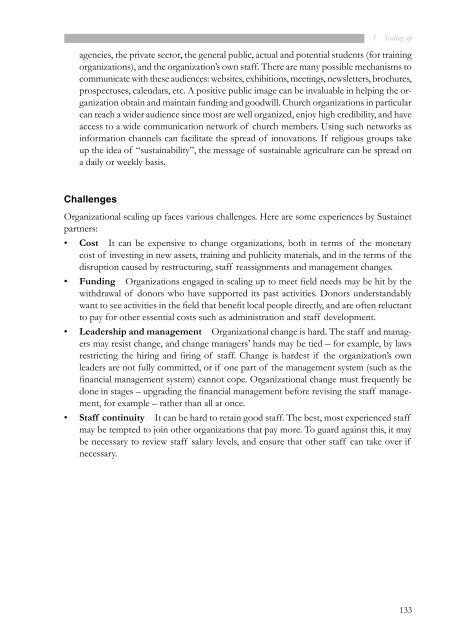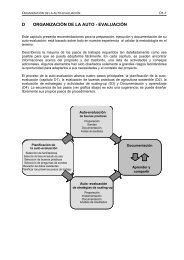cases from tanzania - Sustainet
cases from tanzania - Sustainet
cases from tanzania - Sustainet
Create successful ePaper yourself
Turn your PDF publications into a flip-book with our unique Google optimized e-Paper software.
5 Scaling up<br />
agencies, the private sector, the general public, actual and potential students (for training<br />
organizations), and the organization’s own staff. There are many possible mechanisms to<br />
communicate with these audiences: websites, exhibitions, meetings, newsletters, brochures,<br />
prospectuses, calendars, etc. A positive public image can be invaluable in helping the organization<br />
obtain and maintain funding and goodwill. Church organizations in particular<br />
can reach a wider audience since most are well organized, enjoy high credibility, and have<br />
access to a wide communication network of church members. Using such networks as<br />
information channels can facilitate the spread of innovations. If religious groups take<br />
up the idea of “sustainability”, the message of sustainable agriculture can be spread on<br />
a daily or weekly basis.<br />
challenges<br />
Organizational scaling up faces various challenges. Here are some experiences by <strong>Sustainet</strong><br />
partners:<br />
• Cost It can be expensive to change organizations, both in terms of the monetary<br />
cost of investing in new assets, training and publicity materials, and in the terms of the<br />
disruption caused by restructuring, staff reassignments and management changes.<br />
• Funding Organizations engaged in scaling up to meet field needs may be hit by the<br />
withdrawal of donors who have supported its past activities. Donors understandably<br />
want to see activities in the field that benefit local people directly, and are often reluctant<br />
to pay for other essential costs such as administration and staff development.<br />
• Leadership and management Organizational change is hard. The staff and managers<br />
may resist change, and change managers’ hands may be tied – for example, by laws<br />
restricting the hiring and firing of staff. Change is hardest if the organization’s own<br />
leaders are not fully committed, or if one part of the management system (such as the<br />
financial management system) cannot cope. Organizational change must frequently be<br />
done in stages – upgrading the financial management before revising the staff management,<br />
for example – rather than all at once.<br />
• Staff continuity It can be hard to retain good staff. The best, most experienced staff<br />
may be tempted to join other organizations that pay more. To guard against this, it may<br />
be necessary to review staff salary levels, and ensure that other staff can take over if<br />
necessary.<br />
133




